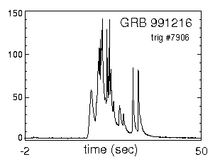
In gamma-ray astronomy, gamma-ray bursts (GRBs) are immensely energetic explosions that have been observed in distant galaxies, described by NASA as "the most powerful class of explosions in the universe". They are the most energetic and luminous electromagnetic events since the Big Bang. Bursts can last from ten milliseconds to several hours. After an initial flash of gamma rays, a longer-lived "afterglow" is usually emitted at longer wavelengths.

The Compton Gamma Ray Observatory (CGRO) was a space observatory detecting photons with energies from 20 keV to 30 GeV, in Earth orbit from 1991 to 2000. The observatory featured four main telescopes in one spacecraft, covering X-rays and gamma rays, including various specialized sub-instruments and detectors. Following 14 years of effort, the observatory was launched from Space Shuttle Atlantis during STS-37 on April 5, 1991, and operated until its deorbit on June 4, 2000. It was deployed in low Earth orbit at 450 km (280 mi) to avoid the Van Allen radiation belt. It was the heaviest astrophysical payload ever flown at that time at 16,300 kilograms (35,900 lb).

Neil Gehrels Swift Observatory, previously called the Swift Gamma-Ray Burst Explorer, is a NASA three-telescope space observatory for studying gamma-ray bursts (GRBs) and monitoring the afterglow in X-ray, and UV/Visible light at the location of a burst. It was launched on 20 November 2004, aboard a Delta II launch vehicle. Headed by principal investigator Neil Gehrels until his death in February 2017, the mission was developed in a joint partnership between Goddard Space Flight Center (GSFC) and an international consortium from the United States, United Kingdom, and Italy. The mission is operated by Pennsylvania State University as part of NASA's Medium Explorer program (MIDEX).
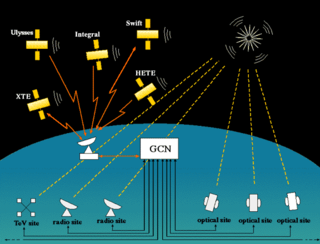
The General Coordinates Network (GCN), formerly known as the Gamma-ray burst Coordinates Network, is an open-source platform created by NASA to receive and transmit alerts about astronomical transient phenomena. This includes neutrino detections by observatories such as IceCube or Super-Kamiokande, gravitational wave events from the LIGO, Virgo and KAGRA interferometers, and gamma-ray bursts observed by Fermi, Swift or INTEGRAL. One of the main goals is to allow for follow-up observations of an event by other observatories, in hope to observe multi-messenger events.

Cornelis A. "Neil" Gehrels was an American astrophysicist specializing in the field of gamma-ray astronomy. He was Chief of the Astroparticle Physics Laboratory at NASA's Goddard Space Flight Center (GSFC) from 1995 until his death, and was best known for his work developing the field from early balloon instruments to today's space observatories such as the NASA Swift mission, for which he was the principal investigator. He was leading the WFIRST wide-field infrared telescope forward toward a launch in the mid-2020s. He was a member of the National Academy of Sciences and the American Academy of Arts and Sciences.
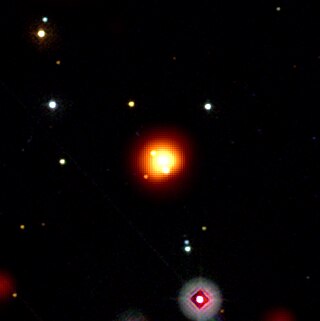
GRB 080913 was a gamma-ray burst (GRB) observed on September 13, 2008. The Swift Gamma-Ray Burst satellite made the detection, with follow-up and additional observations from ground-based observatories and instruments, including the Gamma-Ray Burst Optical/Near-Infrared Detector (GROND) and the Very Large Telescope. At 12.8 billion light-years and redshift of 6.7, the burst was the most distant GRB observed until GRB 090423 on April 23, 2009. This stellar explosion occurred around 825 million years after the Big Bang.

GRB 970508 was a gamma-ray burst (GRB) detected on May 8, 1997, at 21:42 UTC; it is historically important as the second GRB with a detected afterglow at other wavelengths, the first to have a direct redshift measurement of the afterglow, and the first to be detected at radio wavelengths.
The history of gamma-ray began with the serendipitous detection of a gamma-ray burst (GRB) on July 2, 1967, by the U.S. Vela satellites. After these satellites detected fifteen other GRBs, Ray Klebesadel of the Los Alamos National Laboratory published the first paper on the subject, Observations of Gamma-Ray Bursts of Cosmic Origin. As more and more research was done on these mysterious events, hundreds of models were developed in an attempt to explain their origins.

GRB 090423 was a gamma-ray burst (GRB) detected by the Swift Gamma-Ray Burst Mission on April 23, 2009 at 07:55:19 UTC whose afterglow was detected in the infrared and enabled astronomers to determine that its redshift is z = 8.2, which makes it one of the most distant objects detected to date with a spectroscopic redshift.
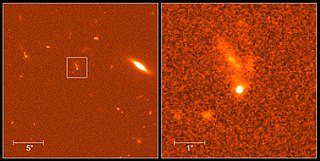
GRB 990123 is a gamma-ray burst which was detected on January 23, 1999. It was the first GRB for which a simultaneous optical flash was detected. Astronomers first managed to obtain a visible-light image of a GRB as it occurred on January 23, 1999, using the ROTSE-I telescope in Los Alamos, New Mexico. The ROTSE-I was operated by a team under Dr. Carl W. Akerlof of the University of Michigan and included members from Los Alamos National Laboratory and Lawrence Livermore National Laboratory. The robotic telescope was fully automated, responding to signals from NASA's BATSE instrument aboard the Compton Gamma Ray Observatory within seconds, without human intervention. In the dark hours of the morning of January 23, 1999, the Compton satellite recorded a gamma-ray burst that lasted for about a minute and a half. There was a peak of gamma and X-ray emission 25 seconds after the event was first detected, followed by a somewhat smaller peak 40 seconds after the beginning of the event. The emission then fizzled out in a series of small peaks over the next 50 seconds, and eight minutes after the event had faded to a hundredth of its maximum brightness. The burst was so strong that it ranked in the top 2% of all bursts detected.

Gamma-ray astronomy is the astronomical observation of gamma rays, the most energetic form of electromagnetic radiation, with photon energies above 100 keV. Radiation below 100 keV is classified as X-rays and is the subject of X-ray astronomy.
GRB 000131 was a gamma-ray burst (GRB) that was detected on 31 January 2000 at 14:59 UTC. A gamma-ray burst is a highly luminous flash associated with an explosion in a distant galaxy and producing gamma rays, the most energetic form of electromagnetic radiation, and often followed by a longer-lived "afterglow" emitted at longer wavelengths.
GRB 020813 was a gamma-ray burst (GRB) that was detected on 13 August 2002 at 02:44 UTC. A gamma-ray burst is a highly luminous flash associated with an explosion in a distant galaxy and producing gamma rays, the most energetic form of electromagnetic radiation, and often followed by a longer-lived "afterglow" emitted at longer wavelengths.
GRB 011211 was a gamma-ray burst (GRB) detected on December 11, 2001. A gamma-ray burst is a highly luminous flash associated with an explosion in a distant galaxy and producing gamma rays, the most energetic form of electromagnetic radiation, and often followed by a longer-lived "afterglow" emitted at longer wavelengths.
GRB 031203 was a gamma-ray burst (GRB) detected on December 3, 2003. A gamma-ray burst is a highly luminous flash associated with an explosion in a distant galaxy and producing gamma rays, the most energetic form of electromagnetic radiation, and often followed by a longer-lived "afterglow" emitted at longer wavelengths.

GRB 101225A, also known as the "Christmas burst", was a cosmic explosion first detected by NASA's Swift observatory on Christmas Day 2010. The gamma-ray emission lasted at least 28 minutes, which is unusually long. Follow-up observations of the burst's afterglow by the Hubble Space Telescope and ground-based observatories were unable to determine the object's distance using spectroscopic methods.

GRB 130427A was a record-setting gamma-ray burst, discovered starting on April 27, 2013. This GRB was associated to SN 2013cq, of which the appearance of optical signal was predicted on May 2, 2013 and detected on May 13, 2013. The Fermi space observatory detected a gamma-ray with an energy of at least 94 billion electron volts. It was simultaneously detected by the Burst Alert Telescope aboard the Swift telescope and was the brightest burst Swift had ever detected. It was one of the five closest GRBs, at about 3.6 billion light-years away, and was comparatively long-lasting.
Fermi's Large Area Telescope (LAT) recorded one gamma ray with an energy of at least 94 billion electron volts (GeV), or some 35 billion times the energy of visible light, and about three times greater than the LAT's previous record. The GeV emission from the burst lasted for hours, and it remained detectable by the LAT for the better part of a day, setting a new record for the longest gamma-ray emission from a GRB.
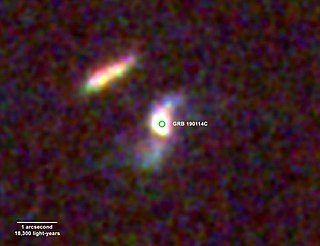
GRB 190114C was an extreme gamma-ray burst explosion from a galaxy 4.5 billion light years away (z=0.4245; magnitude=15.60est) near the Fornax constellation, that was initially detected in January 2019. The afterglow light emitted soon after the burst was found to be tera-electron volt radiation from inverse Compton emission, identified for the first time. According to the astronomers, "We observed a huge range of frequencies in the electromagnetic radiation afterglow of GRB 190114C. It is the most extensive to date for a gamma-ray burst." Also, according to other astronomers, "light detected from the object had the highest energy ever observed for a GRB: 1 Tera electron volt (TeV) -- about one trillion times as much energy per photon as visible light"; another source stated, "the brightest light ever seen from Earth [to date] ... [the] biggest explosion in the Universe since the Big Bang".

GRB 221009A also known as Swift J1913.1+1946 was an unusually bright and long-lasting gamma-ray burst (GRB) jointly discovered by the Neil Gehrels Swift Observatory and the Fermi Gamma-ray Space Telescope on October 9, 2022. The gamma-ray burst was around seven minutes long, but was detectable for more than ten hours following initial detection, and for several hours was bright enough in visible frequencies to be observable by amateur astronomers. Despite being over 2 billion light-years away, it was powerful enough to affect Earth's atmosphere, having the strongest effect ever recorded by a gamma-ray burst on the planet. The peak luminosity of GRB 221009A was measured by Konus-Wind to be ∼ 2.1 × 1047 J/s and by Fermi-GBM to be ∼ 1.0 × 1047 J/s over the 1.024s interval. A burst as energetic and as close to Earth as 221009A is thought to be a once-in-10,000-year event. It was the brightest and most energetic gamma-ray burst ever recorded, being deemed the "BOAT", or brightest of all time.
